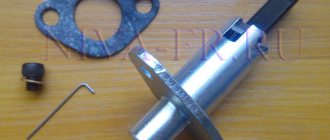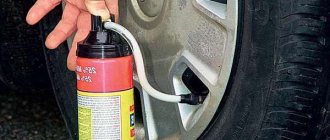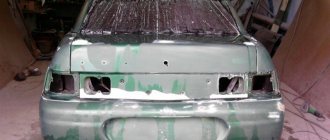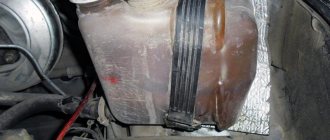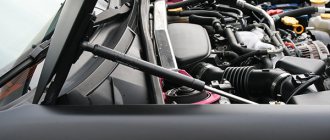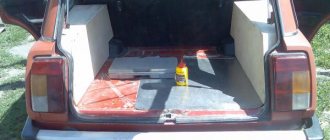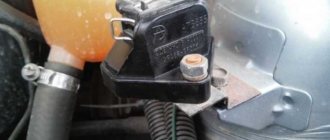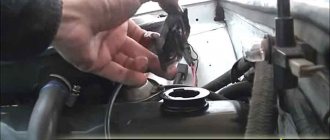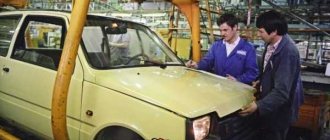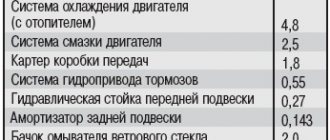The formation of corrosion on a car body can lead not only to the loss of the appearance of the car, but with prolonged exposure to the complete destruction of thin metal over the entire area. If the engine or transmission after a major overhaul, in terms of its main characteristics, practically does not differ from the new state, then eliminating numerous areas of metal rusting can be very difficult, and sometimes even economically impractical.
It is much easier to prevent the destruction of a metal body than to then try to patch through holes using welding or putty. One of the most effective means for preventing the formation of corrosion on a car body is Movil.
Anticorrosive is deservedly popular among car enthusiasts. How to apply Movil to a metal surface, as well as which Movil is best for a car, will be described in detail in the article.
What is "Movil"?
Many motorists call any anti-corrosion agent for a car Movil, but this is incorrect. The original Movil contains the following components:
- Engine oil.
- Drying oil.
- Anti-corrosion substances.
If an anti-corrosion drug has a different composition, then it cannot be called Movil. A product for protecting the body from rust, under the original name “Movil,” was simultaneously developed by research institutes located in Moscow and Vilnius, for which it received its name from the first letters of these cities.
Anticorrosive agent was invented in the last century, but despite the huge range of various anti-corrosion agents available on the Russian market, this anti-corrosion agent is still in high demand among car owners today, due to its low cost and high quality.
To know which Movil to choose for your car and how to use this anti-corrosion agent, you need to determine what type of rust preventative to purchase for treating the body.
Types of anticorrosive
Types of Movil for cars are presented in 3 categories:
1. Aerosols are the most popular and convenient means for applying anti-corrosion composition.
The price of a 520 ml can ranges from 200 to 300 rubles. Treating the car body with such packaging will cost the motorist much more, due to the gas inside the canister, which is used for spraying.
The inconvenience of using this type of anticorrosion agent may also lie in the need to keep the canister in a vertical position, so for anti-corrosion treatment it is better to purchase a canister equipped with a special tube with a spray at the end.
2. Liquid Movil is an inexpensive option for use as an anti-corrosion treatment. The cost of a 3-liter canister is only 300 - 400 rubles.
The consistency of the liquid composition allows for effective treatment of hidden cavities. The product is easily applied to thresholds and internal door cavities. You can get the most even distribution of the substance inside hidden cavities using an original spherical nozzle, which allows you to process every square centimeter of the internal area of the metal elements of the body.
3. Paste-like Movil, most often sold in tin or plastic packaging, in the form of cans.
The cost of such a drug for treating a car is about 200 rubles. per package weighing 0.86 kg. The product is applied to the surface to be treated with a brush, and to treat internal cavities it is diluted with a solvent.
After a vehicle body treatment product has been selected, it is necessary to thoroughly prepare the body surface on which the anti-corrosion compound will be applied.
Preparing the car
The underbody of the car is most often subjected to anti-corrosion treatment. This part of the body is most susceptible to destructive processes, especially when the car has to be operated in high humidity.
Mechanical damage from stones and sand from under the wheels also causes significant damage to the lower part of the car body. The following body elements are subjected to anti-corrosion treatment using Movil:
- Spars.
- Floor thresholds.
- Door pockets.
- Front and rear arches.
- Central pillars.
- Headlight covers.
All listed places must be properly prepared. First of all, it is necessary to thoroughly clean the surface to be treated from dirt and dust. For this purpose, you can use a portable car wash with the addition of special detergents that will clean the surface not only of dirt, but also of oily deposits.
After thorough cleaning. The surface on which Movil will be applied must be free from moisture. If the treatment is carried out in the summer, then it is enough to dry the car in the open air for several hours. In cold or damp seasons, you need to use a compressor to remove moisture. Blowing with compressed air will reliably remove moisture from the surface, after which it will be possible to apply the working solution to the metal surface without any obstacles.
After cleaning the surface of the underbody of the car from contamination, you should inspect the paintwork of the lower part of the body. If areas of paint peeling or swelling of the paint are identified, then such areas must be cleaned with a wire brush or coarse sandpaper. If pockets of rust are found on the underside of the car, such places must also be properly treated before applying Movil.
You can also use sandpaper or a grinder to remove corrosion.
When the metal surface is cleaned, it should be treated with any rust converter in order to stop the destructive process in the metal.
Features of the autopreservative Movil
Operating principle and composition of the mixture
Since its inception, the formula of the autopreservative has not changed much - it is still a film-forming inhibited petroleum composition (PINS). The type of converter used in the mixture varies by manufacturer. The functional side of the composition is as follows:
- Penetration of hydrated iron oxide into micropores due to the presence of penetrate inhibitors in the composition.
- Transformation of oxides into a non-corrosive configuration of iron.
- Formation of a protective surface film based on polymer resins.
What does it consist of?
The last factor excludes the access of oxygen and moisture, due to which further oxidation of the part is impossible. You can understand what Movil for cars is and how to use this product after studying its composition. The overall characteristics of the mixture are formed by its main “ingredients”:
- Drying oil.
- White Spirit.
- Inhibitors.
- Kerosene.
- Engine oil.
- Rust converter.
You can find out which converter is present in the mixture from the information on the can. For example, the Agat-Avto concern has used tannin, which reformats oxides into iron tannate.
Who produces?
On the shelves of domestic auto stores you most often find Movil with a converter from the following manufacturers:
- Astrochem - Antiruster aerosol with a rust converter.
- Agat-Auto - Movil corsenvant with converter.
- Development of PKF - liquid and aerosol HH MasterWax with converter.
- Eltrans is an aerosol with a converter.
The product packaged in cans is half the price of aerosol packaging. If you plan to treat the body with liquid Movil using a brush, then there is an opportunity to save money. On the other hand, there are places where you can’t reach with a simple brush, and then you can’t do without an aerosol.
You can still find car owners who do not recognize anything other than Cannon Tallow, a preservative petroleum lubricant. They justify their choice by reliability and low cost. However, beginners are faced with the problem of preparing the mixture, since it is difficult to process the internal cavities of a car with a thick consistency, so there is no reason for them to choose “pussalo”.
What is Movil
A problem such as metal destruction is easier to prevent than to fix later. A product called Movil is one of the popular ones. Many people use it, but it turns out that many do not know how to apply it correctly. The quality of the work performed depends on the technology for applying the anti-corrosion composition.
Movil is any anti-corrosion substance. It must contain the following mandatory substances:
- engine oil;
- drying oil;
- components that protect against corrosion.
If the anti-rust product contains other substances, has a different composition, then this product is no longer Movil. The original Movil product was developed several decades ago.
Where did the name Movil come from? Answer: because this substance was invented by chemists from Moscow and Vilnius.
Due to its low price and high quality, Movil has been used for more than 50 years to prevent and eliminate corrosion of metal car bodies.
In one issue I published material about Gravitex for cars. Look, this remedy is also effective. The question of how to choose this substance and how to use it was discussed.
There is also a technology to isolate the metal surface from oxygen in the air. This can be done either with paints or film. For example, there is a film against chipping.
Movil among other anticorrosives
The modern motorist adopted many different types of anticorrosion agents.
The most common of them are anti-gravel, very widely represented by Hi-Gear and Body. As a rule, these are aerosol cans with a high cost. Some of them contain rubber to enhance the protective functions of the composition. The next type is mastics. These are paste-like compositions that are also used to treat the body in order to protect it from corrosion by covering up the cracks that have formed.
The third on the list will be Movil. This is a composition for anti-corrosion treatment that includes motor oil, drying oil and additives. A product with a different composition cannot be called Movil.
You cannot process an element with Auto Movil and forget it. Unfortunately, over time, Movil is washed away.
Historical reference
Movil received its original name thanks to the developers. This type of anti-corrosion product was created by two interacting research institutes in the middle of the last century. One of them is located in Moscow, and the other in Vilnius. It was after the first letters of the names of these cities that this preservative was named.
Types of Movil
Today in the car market you can find three types of Movil according to the packaging sold:
- Aerosol. This is the most popular type because it is very convenient to apply by spraying. The aerosol is produced in small quantities, the jar has a volume of 250 to 300 ml. The cost of one can is up to 700 rubles. But, if you process the entire body, then in the end you will need several thousand rubles for Movil. One of the disadvantages of aerosol Movil is that when applying it, the can must be kept vertically all the time.
- In a liquid state. This is the cheapest type. Sold in a 3 liter canister. Depending on who the manufacturer is, the price is 300-400 rubles. Liquid, as we know, easily penetrates into the most inaccessible places, seams. The set includes a nozzle in the form of a ball. It is needed for ease of application to the body.
- In a pasty state. Sold in a plastic or iron can. The volume of a can of 860 grams costs about 300 rubles. The paste is thick, it is convenient to treat open surfaces with a wide brush, but seams and hard-to-reach places will have to be treated with the same paste diluted with a solvent.
Now you have chosen the form in which you need Movil, now you need to find out how to use it.
Car body preparation
Usually, the parts of the car body that rot the most from corrosion are the bottom and wings. The bottom of the vehicle is destroyed faster in areas near the sea, that is, with high humidity. And if salt or reagents get on the body, then in general the destruction of the metal occurs much faster.
Which parts of the body should be treated with anti-rust and anti-corrosion:
- spars;
- door sills;
- floor;
- bottom;
- central pillars;
- headlight housings;
- arches of the front and rear wings.
First, thoroughly wash the surfaces to be treated. If you have a mini sink, for example, a Karcher, then select the appropriate nozzle and use a stream of water to beat off the dirt. After that, wait for it to dry completely. If the weather is rainy at this time, you can dry it in the garage with a compressor.
The correct way to apply Movil
Few people go to a service station to have their body treated against corrosion. Because it’s expensive, and you don’t know how they’ll do it. Therefore, it is best to protect the body from rust with your own hands. Properly applied coating lasts for several years.
Expensive special equipment is not required to apply Movil. If you take liquid Movil, then you will need a sprayer (for example, the one used to process potatoes). If there is no sprayer, then it can be applied with a brush. Movil must be diluted with a solvent, for example, White Spirit or No. 646 solution.
In order for the applied anticorrosive to serve for a long time and efficiently, you should wait several days after treating the car body. Don't ride it right away.
Safety precautions
In any case, safety precautions should be observed. Otherwise, there is no point in improving something if you spoil your invaluable health.
When working with Movil we do the following:
- First read on the packaging what the Movil drying time is. Usually, the smell of chemicals in the salon lingers for several days after treatment. Therefore, waiting several days before operating the vehicle also eliminates the risk of poisoning through the respiratory tract.
- Since Movil contains chemical components, it releases vapors into the air when it evaporates; they are poisonous. It is advisable to use a gas mask or a good respirator and open the garage for ventilation.
- If Movil gets on the skin of the body or in the eyes, they can get burns, so immediately rinse with clean water. Does not work with this substance in sleeveless vests and shorts. The body must be completely covered.
- We protect our eyes with safety glasses.
Video
For those who don't like to read, after watching this video you will know what MOVILLE is?
And this video received several thousand likes for useful advice. How to remove saffron milk caps in 5 minutes.
Improved new mobile in a can.
The bodies of modern cars are able to withstand through corrosion for an average of 5 to 10 years, then gradually the rust begins to “eat up” the body parts, and over time, pockets of rust appear on the bottom and wheel arches. To ensure that the body iron lasts as long as possible, special protective agents are used, in particular, Movil is used to treat the lower part and hidden cavities of the body.
The anti-corrosion coating protects the metal from premature rusting, which occurs as a result of the negative influence of the environment; the metal corrodes due to interaction with water (moisture) and oxygen. Various bitumen mastics and special chemical compositions applied to body iron allow you to extend the life of the metal and delay the next repair.
Which body cavities need Movil treatment and why?
There is a misconception that the underbody of a vehicle can be treated with a preservative. This approach is irrational, since only anti-gravel coating can withstand mechanical stress. Anticorrosive agent works effectively in limited places where there is a high probability of corrosion pockets:
- Thresholds. The holes in them allow moisture to penetrate and, as a result, rust to form.
- Front roof pillars. Condensation that occurs due to temperature differences leads to corrosion processes over time.
- Spars and space between the wheel arch and rear wing.
- Inner plane of the trunk. Often the compartment is lined with felt material, which absorbs and retains moisture well.
- Floors and interior doors. Moisture and condensation quite often accumulate in these places.
- Door seal mounting locations. Water accumulates under the rubber and provokes the formation of rye and mold.
Compositions that help protect the body and body parts from corrosion
For automobiles, the industry has developed various anti-corrosion agents (anti-corrosion agents) that have different chemical components, but perform the same function. The most common brands of body iron protective compounds:
- Movil of various modifications;
- Dinitrol;
- Noxudol;
- Textile;
- all kinds of mastics;
- Prim Anti-noise and so on.
These preservatives are used to treat the underbody of the car and amplifiers, wheel arches, hidden cavities, including doors on the inside, thresholds, and cover the floor inside the cabin with anticorrosive. Important qualities of such preparations are tightness, plasticity, the ability to resist and repel moisture, and good adhesion. If water or dirt gets onto the metal through a layer of anti-corrosion coating, even in very small quantities, the body will quickly rust, and then premature body repair will be required.
Composition and principle of action of Movil
The operating principle of Moville is that this substance penetrates the microscopic pores of iron oxide, and the rust converter transforms the oxides into a special form of iron. In this case, polymer resins leave a protective film on the surface, which prevents subsequent oxidation.
The anti-corrosion agent contains the following ingredients:
- White Spirit;
- machine oil;
- drying oil;
- inhibitors;
- corrosion converter;
- kerosene.
For what surfaces is Movil anticorrosive agent intended?
This anti-corrosion agent is intended for treating metal, including those coated with a layer of paints and varnishes. It is forbidden to treat rubberized elements and surfaces on which synthetic preparations are applied with Movil.
Treatment with Movil - types of chemicals, application methods
Such a protective agent against corrosion as Movil appeared in the Soviet Union; the drug was developed by scientists in Moscow and Vilnius, and therefore its name consists of abbreviated words from these two cities. First of all, the chemical composition was intended for the preservation of cars; its dense elastic layer is able to reliably protect body iron from the penetration of air and moisture.
The standard components included in the anti-corrosion coating are drying oil, machine oil, inhibitor additives, solvents are also present, currently there are various modifications of this drug:
- Movil with zinc;
- classic composition;
- with rust converter;
- with natural wax.
Anticorrosives also differ in the method of application; the standard version of Movil is a thick, viscous liquid; preparations are also produced in the form of a spray, they are sold in aerosol cans. Anticorrosion treatment can be done using a brush or roller, but it is more convenient to apply a layer by spraying the product under pressure. If Movil is packaged in a regular container such as a can, spraying is done using a spray gun, and compressed air is supplied by a compressor.
The modern drug Movil differs significantly from the preservative produced in the USSR; an anti-corrosion agent for protecting the body is now being developed and produced by various companies, produced not only in Russia, but also in Belarus and Lithuania. The most well-known manufacturers of the drug today:
- joint stock company "Nikor" (St. Petersburg);
- PKF (Nizhny Novgorod);
- "Stesmol" (Belarus);
- "Agat-Auto";
- "Astrokhim";
- Limited Liability Company "Eltrans";
- JSC "Elf Filling" (the last four companies mentioned above are Moscow manufacturers).
Among car enthusiasts, the “Movil-NN” brands produced in Nizhny Novgorod and “Movil-2M” from Nizhny Novgorod are quite popular; the preservative composition under the Kerry brand (“Elf Filling”) is also quite well known. The price of the preservative depends on the brand, packaging volume, and the seller himself; the average cost of Movil in a can or jar with a volume of 400-1000 ml is from 130 to 500 rubles.
Communities › Moidodyr › Forum › Movil! What and how?
Hello guys. Right now I'm using the Oka... when I washed the interior... I slightly tore off the carpet under the driver and saw that the bottom was already blooming... I decided to buy MOVILLE! I bought MOVIL-NN Thick in a 900 gram jar, 2 cans. So the question is - How to use it so that later nothing gets spoiled and gets even worse? In other words, what are the nuances of this case? How to smear, what to smear with? How long does it take to dry? In the garage or on the street and so on... in general, whoever smeared it, who knows, please write back, otherwise it will be frosty soon... we need to have time to do everything correctly)) Thank you))
Movil is evil. Both for the corrosion and for the owner of the corrosion. As a rule, Movil does not dry out and constantly stinks of itself. Moreover, nothing can remove the smell. It's like radiation. It is easy to apply. Preferably a dry, warm room and the same car. Apply either with a brush or with an aerosol (preferably). The action provides a certain delay in major body repairs. Once rust has set in, it won’t stop. Only amputation of the infected organ will save you (ugh, details).
this is news (((so what to do? what to do? how to process it then?
I suspect that there are other options besides Movil. The Internet can help you.
I’d like to hear advice first-hand)) because you know, the Internet is a thankless task in some sense.
The advice is simple. As soon as the bucket begins to rot, it needs to be replaced. This method works for me. My last bucket is still a couple of years old without Movil. What about investing in restoration? There are more important things.
And if it’s a factory anticorrosive, is there any use for Movil? Sprayed my fenders
Are you going to drive your car forever? =)
No, well, the car should outlive its owner, that’s for sure. I’m not sure that I’ll be the only one who will ride it all this time, but you need to be prepared for anything...
I think that modern “Koreans” (and not only) are of much higher quality than domestic crafts that are rotting in the first years. In any case, the Goetz 2005, my relative, is like new without anticorrosion. Even though he lives on the street.
It also depends on the city, if you’re knee-deep in reagents all winter, that should also have an effect
I anointed the thresholds with Movil in the winter, I didn’t regret it, it suppresses corrosion a little, filled in chips from stones in the thresholds, it’s better to lubricate with Movil and then with mastic
Uh... Guys. Now Movil is not the same, not the same at all. Movil = MOSCOW + VILNIUS. In the Baltics, a complex of inhibitors was developed at one time together with the Institute of Physical Chemistry of the USSR Academy of Sciences. And after the collapse of the Union, Moville no longer exists. There are fakes - they do not correspond to paintwork either in terms of protective properties or safety. Many movils flow off the metal without forming a protective film; the cat is full of inhibitors in them.
With ordinary bitumen mastics the situation is even worse. They must not crack in the cold, for which plasticizers are added to them, and these are not particularly cheap things. Then, during the thaw, moisture gets into the microcracks, and even worse - electrolyte from the roads, i.e. dirt and salt in an aqueous solution. And the process began.
So if you want to protect your car from corrosion without problems with paintwork, use Mercasol, Dinitrol or Noxudol (there is nothing better). Tectyl endures our winters worse. There is also the Belgian Soudal (I don’t remember exactly how it’s spelled) - a decent drug. From pure oil ones - Canadian Rust Stop A for hidden ones and Rust Stop B for the bottom. But these are the enemies of the painter - because... the preparations are very fluid and create a very thin film. Accordingly, the surface can only be degreased with something like Antex. But they protect well. And yet, modern drugs are environmentally friendly, which fake Movil and waste products cannot boast of.
Do-it-yourself anticorrosive protection of the bottom and sills
Before starting to treat the sills and underbody of the car with a protective agent, you must:
- thoroughly clean the surface to be treated from dust and dirt, blow with compressed air;
- before blowing, it is necessary to remove all rubber plugs in order to gain access to the technological holes and blow out all the dirt from the inside;
- degrease the external body parts (optional, but recommended);
- heat Movil to a temperature of 50-60 degrees Celsius, dilute it with white spirit (for 2 kilograms of anticorrosive agent you need 0.2 liters of white spirit).
To fill the thresholds with an anti-corrosion compound, you must use a powerful compressor and a spray bottle with a “tube” nozzle. All hidden cavities are filled with Movil under pressure, then an even layer of anti-corrosion agent is applied to the surface of the bottom from above.
When treating with anticorrosive agent yourself, it should be taken into account that the preservative emits a very unpleasant odor, so it is strongly recommended to work in a respirator. Odorless Movil is practically never found (if you do not take into account imported aerosols in bottles), so you need to be prepared that the unpleasant spirit will dissipate for quite a long time.
You can pour Movil into the thresholds without using a spray bottle; in this case, you will need a funnel and a piece of rubber hose mounted in one structure. The cavities are filled with an anti-corrosion compound from above; often to carry out such work it is necessary to dismantle the floor in the cabin.
On the outside, anticorrosive coating is applied in two or three layers, the normal ambient temperature for treatment is about +20°C. Each layer must be allowed to dry for one and a half to two hours; on average, approximately 400 g of Movil is spent per square meter of treated surface. After drying, the anti-corrosion agent practically does not smell, does not get dirty, and acquires a brown tint.
How to use Movil
The composition can be applied to metal that has been cleaned to a “bare” appearance, as well as to a painted and primed base. In the cold season, it is better not to use the product - the effectiveness of the treatment drops already at +10 degrees. If the weather is too hot (above +40 degrees), Movil is also not used, so the best time to work with it is late summer, spring, early autumn. To avoid damage to rubber parts, they must be removed or securely closed in advance.
Preparing the car
Areas of future treatment with Movil must be properly prepared. They are cleaned from dust and dirt, and a portable car wash with a water jet pressure of 60–100 atmospheres is best suited for this purpose. If the product is to be applied to the bottom, the car is washed on a lift. To remove oil stains and petrochemical deposits, special detergents are used.
When a car part is already covered with a thick layer of rust, the latter needs to be cleaned with sandpaper or a grinding machine. This point especially applies to loose rust, which after treatment with Movil will immediately begin to flake off. The same rule applies to cracked paint. Immediately before work, the surface is dried in the open air or by force (for example, by connecting a compressor). Deep chips and holes in the metal are repaired with auto putty before applying anticorrosive.
How to dilute Movil
The composition with zinc and corrosion inhibitors in the form of an aerosol is sold in finished form, and it cannot be diluted, and it should not be. The same rule applies to liquids in jars and canisters: adding solvents and other substances will increase the fluidity of the composition, while reducing its quality. Of course, when adding white spirit or solvent, the product will dry even faster, but the strength characteristics of the film will greatly decrease. At the slightest impact, the formed coating will tear due to poor surface tension.
Paste-like Movils sometimes thicken too much and require dilution, otherwise they are quite difficult to apply. You should not use solvents: it is better to slightly heat the composition in a water bath to make it more liquid. Gentle heating is allowed as many times as required.
How to apply Movil
It is important to apply the product in an even layer, the thickness of which after drying will be 40–60 microns. Movil consumption in this case will be approximately 400 g per square meter of surface. The product is most effective when applied in several layers (usually 2-3).
Movil is sprayed onto the base from a cylinder with a long thin nozzle or worked using a pistol. Since application is carried out under pressure, the active composition penetrates into all crevices, cracks and hard-to-reach places. It is better to apply Movil with a brush to open areas and large areas. The intermediate drying time of the layers should be observed (20–30 minutes), as well as the period until Movil is completely dry (2 hours or according to the manufacturer’s recommendations).
Use of Movil aerosol
Anti-corrosion composition in cans has its advantages:
- due to the small size of the bottle, access to almost any body surface is provided; for treating hard-to-reach places, the bottle is equipped with a special nozzle-tube;
- to work with the spray you do not need special equipment and a compressor; the work can be done in almost any conditions;
- As a rule, such a product does not have such a strong odor;
- The car can be used within a few hours after applying the anticorrosive agent.
But aerosols are also not without their disadvantages, and the disadvantages are quite significant:
- The composition is not used as economically, resulting in a less even layer;
- It takes longer to process large areas of the body;
- chemical spray is more expensive.
Using a spray bottle is convenient for treating small surfaces, for example, a welding seam; before use, the bottle with aerosol liquid must be shaken several times.
Instructions for use
Movil is applied to easily accessible places as follows.
- Surface preparation: dirt and rust (the top loose layer of oxides) are removed from the metal, after which it is degreased.
- Drying the surface.
- Applying the 1st layer of Movil (the temperature should be within +10° C to +30° C). The spray is applied through the spray head, and the spout and tube are removable (they are designed for hard-to-reach areas). The liquid is applied with a roller or brush.
- Intermediate drying. If necessary, it can be accelerated by pouring warm air over the treatment area.
- Applying the second and third layers (with another intermediate drying).
- Final drying. The final drying of the composition occurs approximately two hours after applying the last layer.
If during processing the product gets on the front surface, you need to immediately wipe it with a bitumen stain cleaner.
Reviews of aerosol Movil
Although Movil in aerosol form is less popular than car preservative in cans, it is often used by car owners. Users leave various reviews about this tool, there are both negative and positive comments.
Dmitriy. I would like to express my opinion about the Movil preservative in an aerosol can; I bought the Eltrans product in order to treat the front subframe, which has many hidden cavities. The bottle comes with a nozzle with a straw, so spraying the liquid is very convenient. Movil spreads well over the surface, creates a layer similar to solid oil, but emits a rather pungent odor. I liked that this composition is good for treating hard-to-reach places, I can’t say anything about the effect yet, I don’t seem to have noticed any rust. In general, I liked the bottle, the advantages are ease of use, fairly economical consumption (a liter bottle was enough for the entire subframe), I didn’t find any disadvantages.
Yuri. I bought Movil with a rust converter (manufactured by Astrokhim), and was fooled by the advertising. I don’t know who this chemistry helps, for me personally it’s complete nonsense. The product does not combat corrosion at all; the spray nozzle becomes clogged almost immediately and cannot be cleaned. I threw the can in the trash, I won’t buy anything like it again.
Alexei. After 2 years of using my car, I decided to treat the engine compartment, underbody and fenders with a preservative before winter; for this I bought Movil BBF. I did the processing myself, did everything according to the instructions, it took me three bottles, and the total cost was less than 400 rubles. I have been using car preservative for two years now, there are no salt deposits or traces of rust on the car. I recommend this product because it is inexpensive, easy to apply, and gives the desired effect.
Leonid. I have been working with Movil for a long time, since 1998, only then it was sold in a bottle, and I applied it with a brush. Recently I have been using BBF, although the packaging says that it is an anticorrosive agent for hidden cavities, I treat it on my car 2108 and external surfaces, and carry out preventive maintenance before winter. The opinion about the autopreservative is positive; it works effectively, especially since it costs much less than its foreign analogues.
When using Movil, it should be taken into account that the product does not adhere well to mastic, corrodes rubber parts, and is a fairly toxic substance. And you should not apply an anti-corrosion compound to a rusty metal surface; the metal under the anti-corrosion layer will continue to rot. In general, this product quite effectively protects the car body from premature corrosion and does not allow new rust to appear under the protective coating layer.
How should Movil be applied?
Experts recommend treating the car once every two years, and residents of large cities should resort to treating the bottom and sills of the car before each winter. This is necessary in order to prevent the appearance of rust and “save” the car from rotting.
There are some nuances when treating a body with Movil. Here are the main ones:
- It is worth remembering that the product does not interact with synthetic materials and, upon contact with them, renders the latter unusable.
- You should not treat the surface of the car's underbody and sills if they have already been treated with mastic.
- If the oxidizing agent gets on the paintwork, then this area must be immediately treated with a bitumen stain cleaner.
